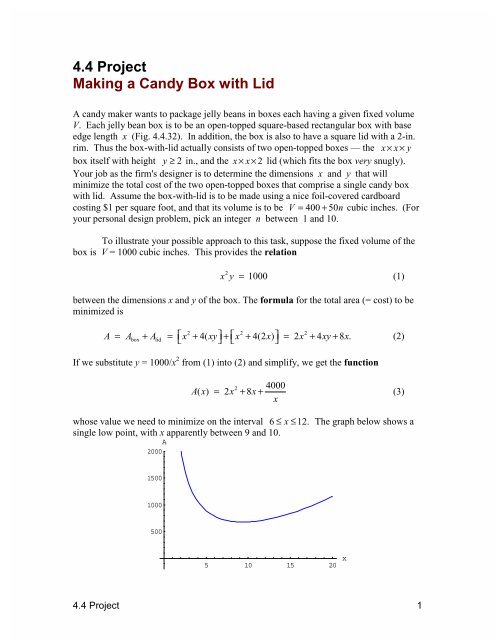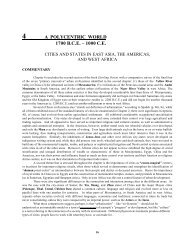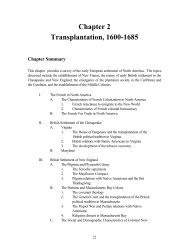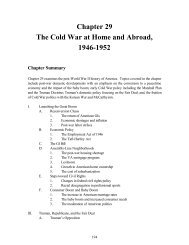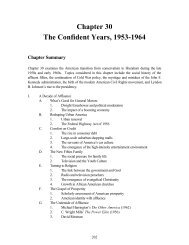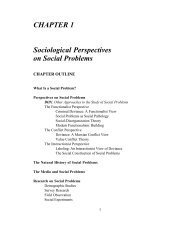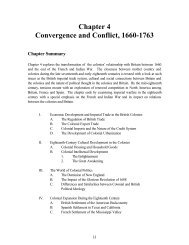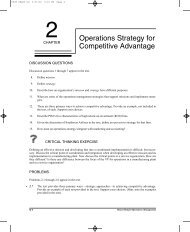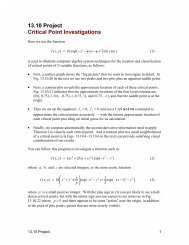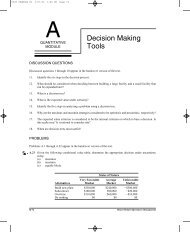4.4 Project Making a Candy Box with Lid
4.4 Project Making a Candy Box with Lid
4.4 Project Making a Candy Box with Lid
You also want an ePaper? Increase the reach of your titles
YUMPU automatically turns print PDFs into web optimized ePapers that Google loves.
<strong>4.4</strong> <strong>Project</strong><br />
<strong>Making</strong> a <strong>Candy</strong> <strong>Box</strong> <strong>with</strong> <strong>Lid</strong><br />
A candy maker wants to package jelly beans in boxes each having a given fixed volume<br />
V. Each jelly bean box is to be an open-topped square-based rectangular box <strong>with</strong> base<br />
edge length x (Fig. <strong>4.4</strong>.32). In addition, the box is also to have a square lid <strong>with</strong> a 2-in.<br />
rim. Thus the box-<strong>with</strong>-lid actually consists of two open-topped boxes — the x× x× y<br />
box itself <strong>with</strong> height y ≥ 2 in., and the x× x×<br />
2 lid (which fits the box very snugly).<br />
Your job as the firm's designer is to determine the dimensions x and y that will<br />
minimize the total cost of the two open-topped boxes that comprise a single candy box<br />
<strong>with</strong> lid. Assume the box-<strong>with</strong>-lid is to be made using a nice foil-covered cardboard<br />
costing $1 per square foot, and that its volume is to be V = 400 + 50n<br />
cubic inches. (For<br />
your personal design problem, pick an integer n between 1 and 10.<br />
To illustrate your possible approach to this task, suppose the fixed volume of the<br />
box is V = 1000 cubic inches. This provides the relation<br />
2<br />
xy= 1000<br />
(1)<br />
between the dimensions x and y of the box. The formula for the total area (= cost) to be<br />
minimized is<br />
A = A + A = ⎡<br />
⎣x + xy⎤ ⎦<br />
+ ⎡<br />
⎣x + x ⎤<br />
⎦<br />
= x + xy+ x<br />
2 2 2<br />
box lid 4( 4(2 ) 2 4 8 .<br />
If we substitute y = 1000/x 2 from (1) into (2) and simplify, we get the function<br />
<strong>4.4</strong> <strong>Project</strong> 1<br />
(2)<br />
2 4000<br />
Ax ( ) = 2x+ 8x+<br />
(3)<br />
x<br />
whose value we need to minimize on the interval 6 ≤ x ≤ 12. The graph below shows a<br />
single low point, <strong>with</strong> x apparently between 9 and 10.<br />
A<br />
2000<br />
1500<br />
1000<br />
500<br />
5 10 15 20 x
We could zoom in on the low point in this figure, but we know that it is where the<br />
tangent line to the graph is horizontal, and therefore where the derivative A' (x) vanishes,<br />
A'<br />
200<br />
150<br />
100<br />
50<br />
-50<br />
-100<br />
-150<br />
-200<br />
4000<br />
A′ ( x) = 4x+ 8− = 0.<br />
(4)<br />
2<br />
x<br />
5 10 15 20 x<br />
So instead we zoom in on the x-intercept of the graph of A' (x). After several<br />
zooms we get the following graph where we see that x = 9.376 accurate to 3 decimal<br />
places. Then (1) yields y = 1000/9.376 2 = 11.375. Thus our optimal candy-box-<strong>with</strong>-lid<br />
has dimensions 9.38" by 9.38" by 11.38".<br />
A'<br />
0.06<br />
0.04<br />
0.02<br />
-0.02<br />
-0.04<br />
-0.06<br />
-0.08<br />
9.372 9.374 9.376 9.378 9.38 x<br />
Alternatively, you could multiply Eq. (4) by x 2 and simplify to obtain the cubic<br />
equation<br />
3 2<br />
x + 2x − 1000 = 0<br />
(5)<br />
<strong>4.4</strong> <strong>Project</strong> 2
that can be solved either graphically or using a computer algebra system solve<br />
command.<br />
The problem <strong>with</strong> a cylindrical box (instead of a rectangular one) follows the<br />
same pattern — after altering Eqs. (1) and (2) appropriately.<br />
Using a Graphing Calculator<br />
To solve graphically the equation in (3), we first define Y1=4+8-4000/X 2 and plot in the<br />
window 0 ≤ x≤20, −200 ≤ y≤200<br />
:<br />
Here — in lieu of zooming — we have already used our calculator's Calc zero<br />
facility to solve for x = 9.3758 as the solution accurate to 4 decimal places. It follows<br />
that y = 1000/9.3758 2 = 11.3758. Hence the optimal box-<strong>with</strong>-lid has dimensions<br />
9.3758" by 9.3758" by 11.3758".<br />
Alternatively, you can use the solve function that is is entered from the<br />
calculator's CATALOG menu.<br />
Here we've directed that the equation Y2 = 0 -- that is, A'(x) = 0 — be solved,<br />
starting <strong>with</strong> the initial guess x = 9.<br />
<strong>4.4</strong> <strong>Project</strong> 3
Using Maple<br />
We define the area function appearing in Eq. (3) above,<br />
A := x -> 2*x^2 + 8*x + 4000/x:<br />
and proceed to plot its derivative:<br />
plot( D(A)(x), x=0..20, y=-200..200);<br />
Spotting the apparent solution between x = 9 and x = 10 we proceed to solve<br />
numerically:<br />
fsolve( D(A)(x) = 0, x, x=9..10);<br />
9.375810570<br />
Thus x = 9.3758 as the accurate to 4 decimal places. It follows that y = 1000/9.3758 2 =<br />
11.3758. Hence the optimal box-<strong>with</strong>-lid has dimensions 9.3758" by 9.3758" by<br />
11.3758".<br />
Using Mathematica<br />
We define the area function appearing in Eq. (3) above,<br />
A[x_] := 2*x^2 + 8*x + 4000/x<br />
and proceed to plot its derivative:<br />
Plot[A'[x], {x, 0, 20}, PlotRange -> {-200,200}];<br />
<strong>4.4</strong> <strong>Project</strong> 4
200<br />
150<br />
100<br />
50<br />
-50<br />
-100<br />
-150<br />
-200<br />
5 10 15 20<br />
Spotting the apparent solution between x = 9 and x = 10 we proceed to solve<br />
numerically:<br />
FindRoot[A'[x] == 0, {x, 9, 10}]<br />
{x -> 9.37581}<br />
Thus x = 9.3758 accurate to 4 decimal places. It follows that y = 1000/9.3758 2 =<br />
11.3758. Hence the optimal box-<strong>with</strong>-lid has dimensions 9.3758" by 9.3758" by<br />
11.3758".<br />
Using MATLAB<br />
We immediately plot the derivative function appearing in Eq. (4) above,<br />
A := x -> 2*x^2 + 8*x + 4000/x:<br />
and proceed to plot its derivative:<br />
fplot('4*x+8-4000./(x.*2)', [0 20 -200 200])<br />
grid on<br />
Spotting (in the resulting figure shown on the next page) the apparent solution near x = 9,<br />
we proceed to solve numerically:<br />
fzero('4*x+8-4000./(x.^2)',9)<br />
ans =<br />
9.3758<br />
Thus x = 9.3758 accurate to 4 decimal places. It follows that y = 1000/9.3758 2 =<br />
11.3758. Hence the optimal box-<strong>with</strong>-lid has dimensions 9.3758" by 9.3758" by<br />
11.3758".<br />
<strong>4.4</strong> <strong>Project</strong> 5
200<br />
150<br />
100<br />
50<br />
0<br />
-50<br />
-100<br />
-150<br />
-200<br />
0 2 4 6 8 10 12 14 16 18 20<br />
<strong>4.4</strong> <strong>Project</strong> 6


